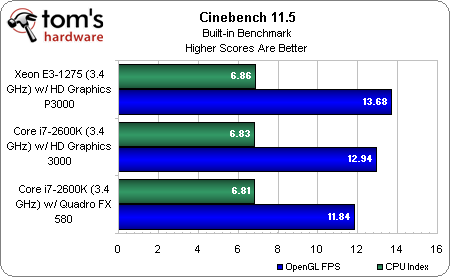Intel Xeon E3-1275 Review: Sandy Bridge Goes Professional
We've already seen Sandy Bridge impress in the desktop space. Does Intel's latest processor architecture have what it takes to dominate the single-socket server and workstation space, too? We run the fastest workstation SKU through our benchmark suite.
Benchmark Results: Rendering
Rendering in Blender is another processor-oriented task, and another benchmark that doesn’t care what sort of graphics card you’re running. That’s good news if you don’t anticipate running other 3D-oriented apps and can get away with HD Graphics P3000 for “free.”
The processor-oriented component of Cinebench is even across the board, just as we’d expect. But the graphics test favors Intel’s Xeon E3-1275. Intel’s Core i7-2600K takes second place. And the Quadro FX 580 falls to last place. Strange? A little. But that’s still an impressive finish for Intel’s Sandy Bridge-based processors in this OpenGL-based benchmark.
Vue is used to create, animate, and render 3D environments, so it’s not surprising that this professional app is well-optimized for multi-core, multi-threaded workstations. Our dual-socket Xeon 5600 system finishes this test in under 10 minutes, and a Core i7-980X can wrap it up in 18. These Sandy Bridge-based configs need around 24 minutes to get the job done. And it doesn’t matter which graphics solution you use, either.
Get Tom's Hardware's best news and in-depth reviews, straight to your inbox.
Current page: Benchmark Results: Rendering
Prev Page Benchmark Results: Media Next Page Benchmark Results: Productivity-
dragonsqrrl one-shotStop teasing and give us a six core Sandy Bridge CPU!Sandy Bridge-E, LGA 2011 X79, Q4 2011.Reply -
agnickolov Finally a compilation benchmark! Now please make it standard in your test suite for CPUs and storage so there's a real benefit from it all for actual comparisons.Reply -
DavC Thanks for this review Chris, very well covered. I'll probably be refering back to this when it comes to spec our next workstations.Reply -
I think this is a useless review. Why are we comparing Apples to Oranges? Lets compare current generation Xeons to Previous generation Xeons.Reply
-
dgingeri one thing I can attest to: companies who cheap out on their workstations and servers never perform well as companies, and eventually fail.Reply
I've worked with many small businesses, and every one that used a desktop chip for a server or a discount chip (Celeron, Duron, etc) for their desktop computers all performed very poorly. Some seemed to hang on by the sheer will of the owner, and in a couple cases, when the owner got sick for more than a week, the businesses folded like lawn chairs.
I've also seen an Engineering shop of ~30 engineers invest nicely into a real server and real workstations, and had me set up their entire network with SBS. their business ramped up so fast and well that they had to hire several more engineers and outgrew SBS (limited to 50 users at the time) within the next 2 years, and I had to go back and rebuild their domain with full enterprise level software, and add another server specifically for email. the owner said the investment in that SBS system was the best thing he'd invested in the business since he hired his first engineer.
Business owners who do not invest in their IT infrastructure fail at business. It's pretty plain and simple. While investing in good IT gear and software doesn't mean you'll ramp up your business to unheard of heights, it does give you a major leg up on the competition. -
given the option of a cheaper Xenon that does not have the P3000 im pretty sure 90% of companies would choose that option, discreet graphics would almost exclusively be employed for the majority of workstation class desktopsReply



